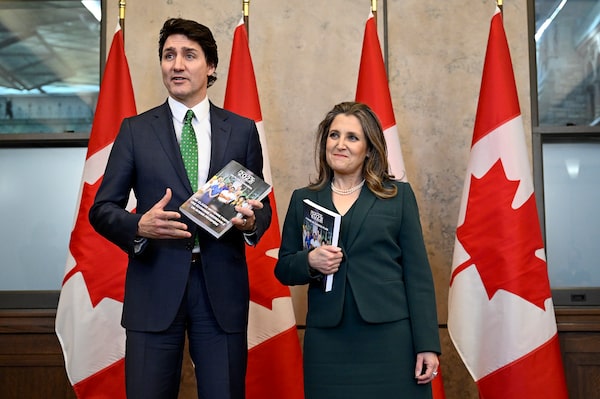
Prime Minister Justin Trudeau and Deputy Prime Minister and Minister of Finance Chrystia Freeland arrive to deliver the federal budget in the House of Commons on Parliament Hill in Ottawa on March 28.Justin Tang/The Canadian Press
If you’re struggling to understand the new alternative minimum tax rules announced in the federal government’s recent budget, the experts don’t blame you.
“The AMT is definitely one of the most complicated tax regimes from our perspective,” said Blair Evans, assistant vice-president of tax and estate planning at IG Wealth Management.
Finance Minister Chrystia Freeland’s budget last month introduced changes to the tax scheme meant to ensure that some of the richest Canadians aren’t able to make massive deductions from their income to lower their tax bill.
Only a very small number of Canadians are affected by AMT – about 70,000 paid AMT under the old rules. Mr. Evans said the new rules will likely have the desired effect of making the highest earners pay more than before, while resulting in a smaller share of Canadians paying AMT tax.
What is AMT?
Some of the highest-earning Canadians are paid in more ways than just a salary. They receive income through dividends, stock options or selling shares.
Non-salaried income is generally taxed at a lower rate, and richer Canadians could pay less tax as a result, says Steven Sitcoff, a partner with McMillan LLP.
The AMT, as its name suggests, is an alternative method to calculate income tax that ensures that everyone pays their share.
It accomplishes this by imposing limits on the deductions that people can claim to ensure that they are not getting away with paying very little income tax. For example, 100 per cent of losses on investments can usually be deducted from your income under the regular tax regime. Under AMT, only 50 per cent of investment losses can be deducted.
It also more heavily taxes non-ordinary forms of income such as stock options. Under the new rules, 100 per cent of proceeds from stock options will count towards your income. At the moment, just 80 per cent of such proceeds are considered income.
Another example is capital gains, or profit made from the sale of investments. Under regular tax rules, only 50 per cent of capital gains are taxable. Under the new AMT rules, 100 per cent are taxable.
Once AMT rules are used to determine a total income, it imposes a flat tax rate for the entirety of that income. This is different from the regular income-tax system, which is on a progressive scale that gets higher as people earn more.
Anyone making more than $173,000 is required to calculate their tax owing using both the AMT method and the regular method. Whichever results in a higher amount of tax payable is the one that’ll be used.
What changed with AMT this year?
Mr. Evans says there were three main ways that the government changed AMT.
The first is that they increased the flat tax rate used to calculate AMT to 20.5 per cent from 15 per cent. This means most people subject to AMT will pay more than they used to.
The second was that they increased the tax burden for non-ordinary forms of income (such as capital gains, as mentioned above). For example, 100 per cent of your capital gains on investments now count as income, up from 80 per cent.
The third measure was to increase what is called the AMT exemption amount. It used to be $40,000, but now has been more than quadrupled to $173,000. The exemption amount is essentially a deduction from your total taxable income under the AMT regime.
Jeffrey Zhang, a spokesperson with H&R Block, says this increased exemption amount effectively balances out the changes and ensures only the highest-income earners will pay more.
Because the deduction is so large, it could result in a lower amount of tax owed by people who only make a little more than the exemption, or an exemption from AMT altogether. (Mr. Zhang says this includes people in the $200,000 to $300,000 range.) At the same time, the increased tax rate and the heavier weight on non-ordinary income mean that the wealthiest are very likely to pay more.
How will this affect the overall amount of tax collected?
The government says the changes to AMT will generate $2.95-billion more over the next five years combined from roughly 32,000 Canadians.
The extra revenue accounts for the tax cut that about 38,000 Canadians are expected to get because of the larger AMT deduction. Mr. Evans said many people who would previously have paid tax under AMT rules could now pay regular taxes because of that deduction.
The exact change in AMT taxes each person will pay is highly variable, because the many different kinds of income they make are calculated with different weightings.
With taxation already at a high rate in Canada relative to those of other G7 countries, Mr. Sitcoff characterizes the changes to this tax scheme as the lesser of two evils if the government wants to increase tax revenue, because the other option would be to simply raise taxes across the board for individuals or corporations.
Are you a young Canadian with money on your mind? To set yourself up for success and steer clear of costly mistakes, listen to our award-winning Stress Test podcast.